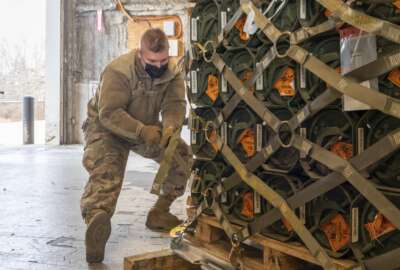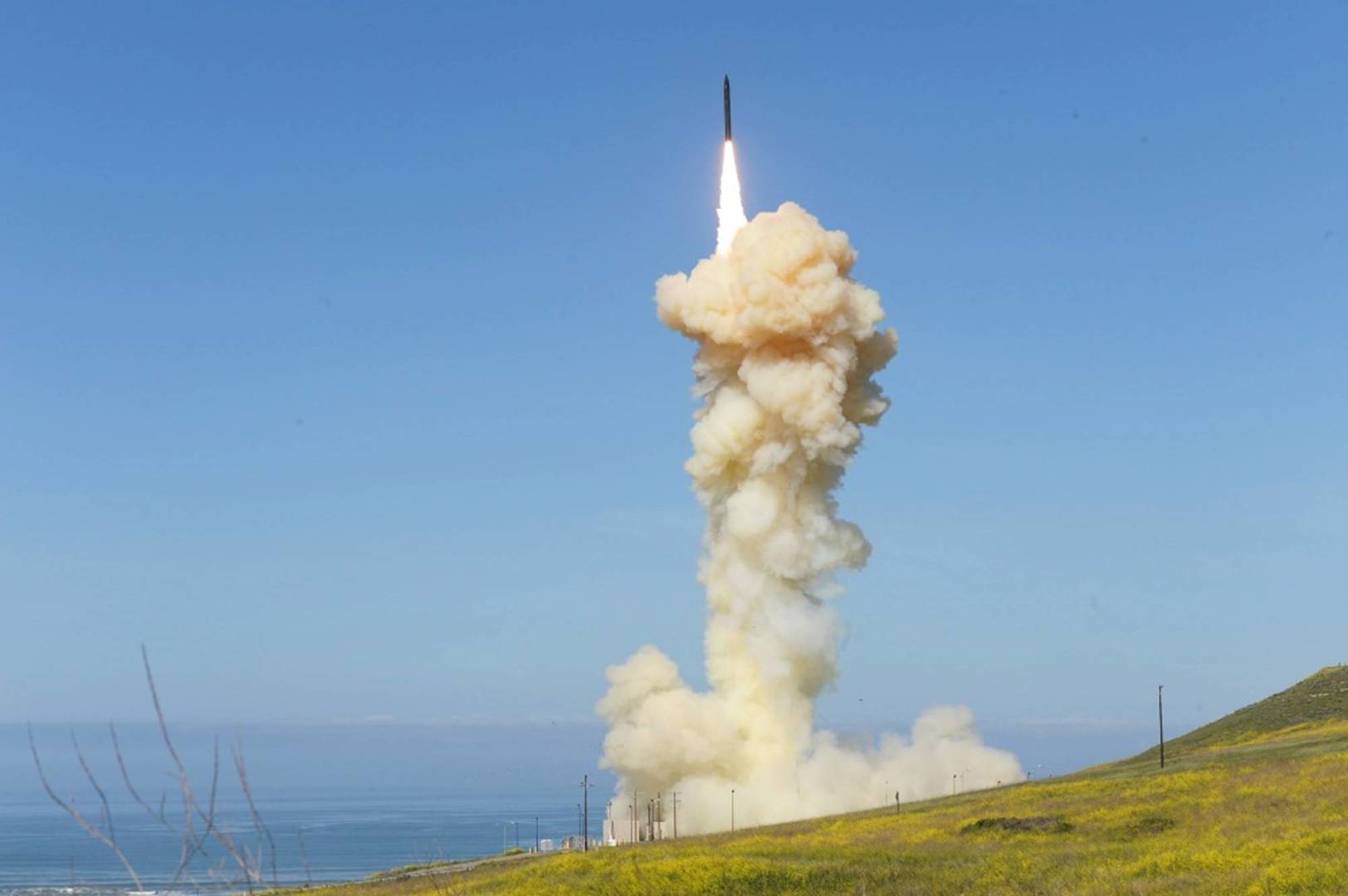
Development of better military explosives and propellants never ceases
The National Armaments Consortium is a coalition of industry groups, whose members work on the next generation of ordnance and the energetics that power them.
The National Armaments Consortium is a coalition of industry groups, whose members work on the next generation of ordnance and the energetics that power them. At last week’s Association of the U.S. Army conference, the Federal Drive Host Tom Temin got an update on a weapons summit coming up soon in Huntsville that will combine three parts of the consortium: Naval Energetics Systems and Technologies(NEST), the Aviation and Missile Technology Consortium, and the Defense Ordnance Technology Consortium. All three are eligible for the Defense Department’s use of other transaction authorities. For more on this matter, Temin spoke with the Vice President for Customer Engagement at the Consortium, Army Brig. Gen. Al Abramson
Interview Transcript:
Al Abramson [Other Transaction Authorities (OTAs)] is a really great thing. It’s a tool that Congress has allowed us, the Department of Defense, to use as a tool to get after the next round of capabilities. And so one to three, November, we’re going to have a summit in Huntsville at one of our in Branson. And it’s going to be the first time that we bring the consortiums that are part of the National Armaments Consortium, which consists of DOTC, AMTC and NEST. DOTC is out of Picatinny, AMTC is in Huntsville, and NEST is out of Indian Head, the Navy folks. And we’re bringing those programs together the first time that we’ve ever done that. And we’re going to brief some government requirements to our members, about 1,000 members, 1,070 members that we have within the National Army Consortium. And we’re going to brief those government requirements to our members and try to see if we can get some prototypes out to the warfighter as quickly as possible.
Tom Temin And what is it that is required here? Energetics and they’re part of a system.
Al Abramson They’re part of a system. Great question. A whole host of things, and I was talking to somebody earlier about we need to get what those requirements will be brief. So we have all armament systems, if you will, that covers the boundary from sensor to shooter. So we may get a requirement for barrel construction, barrel wear. We’re getting more and more of our energetics or wearing out our barrels much more rapidly than they have in the past. That is, the government at this time want to have a conversation and do a requirement for improvement on our barrel remains to be seen. So that requirement or that summit is happening one November. We’ve just got that it’s going to be about 50 requirements given. And what we need to do is get those specific requirements out to our members and to the audience so that we can generate some further interest. Right now, we have about 400 people that have already signed up for that. We’re going to have a really good time with government and industry interacting together, getting after some requirement.
Tom Temin Yes, because if you develop a super duper energetic, yeah, as you say, there might be downstream effects that might be not fully understood, such as the physical barrel, the metal wearing out through which the projectile travels and the type of thing you have to do. So it’s really a systems cycle look at the whole issue of thing, of putting something on a target.
Al Abramson That’s a correct statement.
Tom Temin Yeah. And just out of curiosity, there is a new replacement rifle in the Army for the M4. They have a long, elaborate name for it.
Al Abramson The next generation squad weapon. 6.8 RAF. So they have a new one.
Tom Temin Up from 5.6.
Al Abramson From 5.6. So there was a study done about five years ago now. 5.56 and 7.62 were the two ones that we were using. And so 6.8 without getting into classification is really about the sweet spot that provides the lethality that we want our trigger pullers to have as these wars, if you will, and aggressions kind of continue. We want to have that great balance between what that 5.56 and that 7.62 was able to provide our war fighter.
Tom Temin Plus, if you could standardize on one size, then you can focus the organic industrial base and the suppliers externally on one thing and ramp up really fast. And then if someone reaches in their pocket, they don’t have to worry about whether the getting the seven or the five, that’s where they’ll get the 6.8.
Al Abramson But I want to make sure in no way are we moving away from 7.62, are we moving away from 5.56. There is a place for those munitions in our formations. It’s just that we’ve got a bit around that 6.8, which is a sweet spot that will primarily go to those trigger pullers that are at the forefront.
Tom Temin Cavalry Special Operations.
Al Abramson Absolutely.
Tom Temin And what is the energetics development component breakthrough for that round?
Al Abramson Right. And so mostly within that round, it really is the propellant. What type of propellant? Because that round doesn’t explode, if you will, but it’s the propellant and the engineering process that puts that munition together. When I first came over to the armaments enterprise, I thought it was going to be a simple scientific project. In my past life, I work in the Kim bio arena, which is really science and biology and all those kinds of things come into bear. But really within the armaments community, it’s an engineering fate to make a munition as lethal as it is, at the size of which it is. And it’s really kind of an engineering change thing that we go through to make it. So the propellant is the propellant, but how you put that munition together will ultimately end up in certain types of capabilities that it has.
Tom Temin Plus, there’s the engineering to get it exactly precisely right times 10 million.
Al Abramson Right. And so another thing that I learned during the armaments and ammunition enterprise. Precision and accuracy are two different things. Because we can be precise, but we want to make sure that we hit it all the time a particular target. We also want to be accurate. It’s hitting exactly where we want to hit. And those two metrics are measured separately because it has to be precise and it also has to be accurate.
Tom Temin You don’t want to be able to hit consistently the side of a bar. You want to be able to hit consistently the keyhole.
Al Abramson That’s a correct statement.
Tom Temin Tell us about the Joint Energetics Transition office. What’s going on generally in energetic?
Al Abramson So very recently, the Department of Defense, they had a study of just completing a study, the National Energetics plan. Today, our armaments and our energetics are really based off of the science that our grandfathers, if you will, were using. And a lot of those technologies are still being used and put into place today. And the Department of Defense said we need to get over the horizon, energetics, explosive capabilities as we develop these new munitions. And so that national energetics plan has said and established what they call a joint Energetics transition office that will consolidate the Army, Navy, Air Forces, Marines, energetic requirements under one office and say, I understand what the services requirements are as we build these new energetics. So the Army is not off building one in its silo that doesn’t have any use in another service. And so this shadow office will be the one to consolidate all of the services requirements as we look at and as we are nested to building over the horizon energetics, propellant capabilities for our emerging weapons systems. So I think a great opportunity for us to start building what are those munitions, what are those weapon systems that we will need in the United States to continue for us to defend our country moving forward.
Tom Temin And when you say over the horizon, you mean next generation technologically, not necessarily firing it. So far, you can’t see it anymore.
Al Abramson Both. It’s got to start somewhere, right? We’ve got to have that propellant that will push it over the horizon, literally. But next generation at what types of technologies, what type of energetics that are in the laboratories today that would provide ten fold more energetic power, more propellant power that we are currently putting into our weapon system.
Tom Temin So not just a better gunpowder, but maybe something we haven’t heard of.
Al Abramson That’s a correct statement.
Tom Temin Hydrogen bullet or something.
Al Abramson Absolutely.
Tom Temin Atomic bullets.
Al Abramson Atomic bullet, directed energy. All of those kinds of things are now coming into the umbrella of munitions. And how do we control that? Because that’s kind of over the horizon. We don’t see directed energy in squads, not too much proliferated throughout our formations. But one day that might be one of the ways that we use.
Tom Temin Yeah. So in that case, the the energetic would not necessarily have a projectile on the front of it. It’s the energy itself. You’re beaming over there.
Al Abramson Absolutely.
Tom Temin Well, when you put together a joint office. Both the Army and the Navy, let’s say, fire shells out of things that generally look like they operate by the same mechanism, whether it’s a ship mounted gun or a howitzer or something. And they both have weapons that men and women pull the trigger on. When you have a joint office, how far does that go before it devolves into, Well, we need sort of so-called worthy Navy. We have to have this, were the Army we’ve got to have that. I mean, is there a lot of commonality in the energetic search among the services?
Al Abramson So there are. So today there is an office that is currently the Department of Defense has delegated those authorities to the Army, and the Army has further delegated those authorities to the Joint Program Executive Office for Armaments and Ammunition epic into the arsenal. And that authority is called the SMCA mission. Single Manager for Conventional Ammunition. And to your point, if those services have issues with those munitions, they now have a single belly button to go to, that SIMCA, single management conventional ammunition and talk about what those issues are. But now we’re looking at it holistically, and that General Office is going to do that same thing to resolve any problems that any services have. Hopefully, as it stands up will be the mechanism, the single belly button to resolve those problems.
Tom Temin Because ideally you wouldn’t have a Navy version of the 6.8 millimeter round and an Army version and so on.
Al Abramson Right. And rightfully so. So today in that 5.56 and that 7.62, back to that example, JPL armaments and ammunition as a SIMCA builds all 5.56’s for the Army, Navy, Air Force Marines. They do about 90% of today’s conventional munition. It has to come through the SIMCA, and we’re providing the service or they’re providing the services, their ammunition requirement, as you will.
Tom Temin Now, in some areas, the United States is running out of things because of what was shipped to Ukraine. Lord knows what Israel situation will produce in terms of demand.
Al Abramson To include their counter offensive in Ukraine. There was an offensive portion and there’s a counter offensive and all of those mined munitions, if you will. But go ahead.
Tom Temin Well, my question is, what does the defense industrial base look like from an energetic standpoint? Are we self-sufficient and do we have capacity?
Al Abramson I think one, your question. Are we self-sufficient? Yes. Do we have capacity? Clearly, all of these things that you’re talking about has been putting a strain, if you will, on the defense industrial base resiliency as it relates to the demand signal for energetics and explosives and propellant. It absolutely is. As part of the national energetics plan to look at over the horizon capability. It’s also looking at improving the defense industrial base resiliency and firming that up and going through the process of facilitating, modernizing and expanding the capacity of said explosive plants, propellant plants and having a munitions kind of campus in and around the United States. So there are concerted efforts today that there is an acknowledgment that we are putting a demand and a strain on that industrial base, and we’re trying to build that back up. But it doesn’t take overnight. It’s not a light switch that we can do it overnight, but we’re in the process of getting that resilience.
Tom Temin Plus, you have to have economic incentive for people to want to set these things up.
Al Abramson That’s a correct statement. So oftentimes within the industrial base where there’s energetics involved, there’s very little commercial application. So it’s hard. Natural gas community will want to be involved. Right. Because they deal with an explosive mining community. They deal with them. So you have to find those commercial entities that may want to kind of get on board and do their own investment to get part of this process to help build up the defense industrial base resiliency. And again, it’s not a light switch. It doesn’t happen overnight. There are some things that have to go into play, but we’re in the process of building that resiliency back up to help the strain that we’re currently putting on the energetics community.
Tom Temin And just a quick question. The manufacturer of energetics is not like mixing a box of cake mix. It’s pretty high tech, pretty precise and takes some real skill, doesn’t it?
Al Abramson You would be surprised, but one would argue we would offer that a large cake mixing capability is just the same in certain circumstances, in certain steps with building an explosive component, it’s the same thing. It’s still a cake mix, it’s still a mixer, it’s still a auger that you have to have. So there are some commonalities. And the interesting points of that is we’re now bringing those folks into discussions with us and say, Well, since you guys are making these big candy things with these big candy machines, how can you apply that for energetics? And understanding where the similarities are is a great thing as we move forward for the next generation energetics.
Copyright © 2025 Federal News Network. All rights reserved. This website is not intended for users located within the European Economic Area.
Tom Temin is host of the Federal Drive and has been providing insight on federal technology and management issues for more than 30 years.
Follow @tteminWFED





